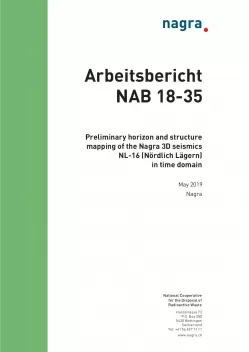
Arbeitsbericht NAB 18-35
Preliminary horizon and structure mapping of the Nagra 3D seismics NL-16 (Nördlich Lägern) in time domain
In the context of the "Sachplan Geologische Tiefenlager" ("Sectoral Plan for Deep Geological Repositories"; SGT), Nagra is currently investigating three siting regions in northern Switzerland: Jura Ost, Nördlich Lägern and Zürich Nordost. As part of these investigations, Nagra carried out three 3D seismic surveys over the years 2015 to 2017 in each of the three areas, in addition to the already existing one, acquired 1997 in Zürich Nordost. This report summarises and illustrates the preliminary horizon and structure mapping of the newly available Nagra 3D seismics NL-16. The survey covered an area of 90.5 km2 in the Nördlich Lägern siting region (NL).
The preliminary horizon and structure mapping of the NL-16 3D seismics presented here is carried out in time domain. It is considered preliminary as borehole interpretation control is presently limited to only one borehole, the pre-existing Weiach borehole, and the refinement processing of the seismic data including depth migration is still ongoing.
The present report summarises the current status of the work and is intended to provide a preliminary structural overview of the siting region focusing focusing on the Mesozoic sedimentary sequence and the larger-scale faults dissecting it. It is intended to serve various planning aspects within SGT Stage 3, most importantly those related to the deep borehole campaign in the NL siting region (e.g. the definition of drilling work programmes) and the basic scoping of underground access facilities.
The synthetic seismogram for the Weiach borehole was revised during this study, considering the newly processed 3D seismic data. For the following seismic-to-well tie, a correlation coefficient of about 76 % was achieved. The further interpretation work was carried out using the Petrel software suite. Based on the seismic-to-well tie with the Weiach borehole, eight seismic marker horizons were defined.
The horizon interpretation was done largely manually on a so-called seedline grid consisting of every 5th in- and crossline of the seismic dataset. Fault interpretation was done in the same context, focusing on larger-scale faults with vertical throws of > 10 ms. The interpretation of fault traces was additionally guided by seismic attribute volumes and horizon slices calculated and processed as part of the interpretation project. The horizon interpretation was completed by applying autotracking algorithms.
Most of the defined marker horizons were found to be well traceable throughout the entire survey area. Notable exceptions include the Top Liassic and Base Mesozoic which show little reflection continuity and weak reflection strength. For these two marker horizons, the autotracking algorithm failed in certain areas, which required a densification of the seedline interpretation. Time thicknesses of the different horizon intervals show variations across the Nördlich Lägern siting region. However, due to the particularly variable tectonic characteristics of the area, their further interpretation remains difficult for the moment.
Among the previously known main faults in the investigation area that were confirmed by the horizon and structure mapping of the NL-16 3D seismics are the Siglistorf Anticline and Eglisau Fault to the north of the Nördlich Lägern siting region and the Baden – Irchel – Herdern Lineament south of it. The so-called "zu meidende tektonische Zone" that was previously interpreted by Nagra on the basis of 2D seismic data to encompass the northernmost part of the siting region was basically confirmed by the NL-16 3D seismics. The preliminary interpretation of the data suggests that this area hosts a large-scale monocline affecting the entire Mesozoic sedimentary stack. Moreover, a strongly segmented fault zone is inferred as dissecting the entire seismic survey, roughly striking ENE-WSW and referred to here as the Weiach – Glattfelden – Eglisau Lineament (WGE). On the Triassic marker horizons, circular structural depressions and polygonal fault patterns which are possibly related to dissolution processes are recognised along the fault zone. The tectonic significance of the WGE lineament is yet unclear. This also accounts for its kinematic relationships with intersecting faults such as the Eglisau Fault and another, more centrally located NW-SE striking structure, referred to here as the Zweidlen Fault. In the otherwise little deformed central and southern part of the NL siting region, the NNW-SSE striking Strassberg Fault is to be mentioned. This fault coincides with the location of a glacially overdeepened valley. Given the status of the available seismic volumes in time domain, it cannot be fully excluded that the reflection discontinuities leading to the interpretation of this fault are due to incomplete static correction.
A notable site-specific feature of the siting region Nördlich Lägern is the so-called "Schwellenzone" within the 'Brauner Dogger' marl sequence that was previously postulated on the basis of 2D seismic data. It is similarly imaged by the 3D seismics NL-16. In order to outline its extent more precisely an additional reflection was picked. The result largely confirms its previously interpreted extent.
Overall, the preliminary horizon and structure mapping of the NL-16 3D seismic dataset provides a lot of new insights into the structural characteristics of the NL siting region and its surroundings. Looking ahead, further interpretation work on the NL-16 dataset shall improve the understanding of the kinematic relationship between the various identified structures. Most importantly, this concerns the newly defined WGE whose development is possibly related to basement faults associated with the Permo-Carboniferous Constance – Frick Trough that was not yet addressed by the 3D seismic mapping presented here. Moreover, it is anticipated to extend the already undertaken mapping of the "Schwellenzone" within the 'Brauner Dogger' marl sequence by an analysis of its seismofacies character. These and other aspects will be further investigated in the later course of the SGT, when the presented seismic interpretation will be further refined considering currently ongoing refinement processing and additional geological information from deep boreholes.
